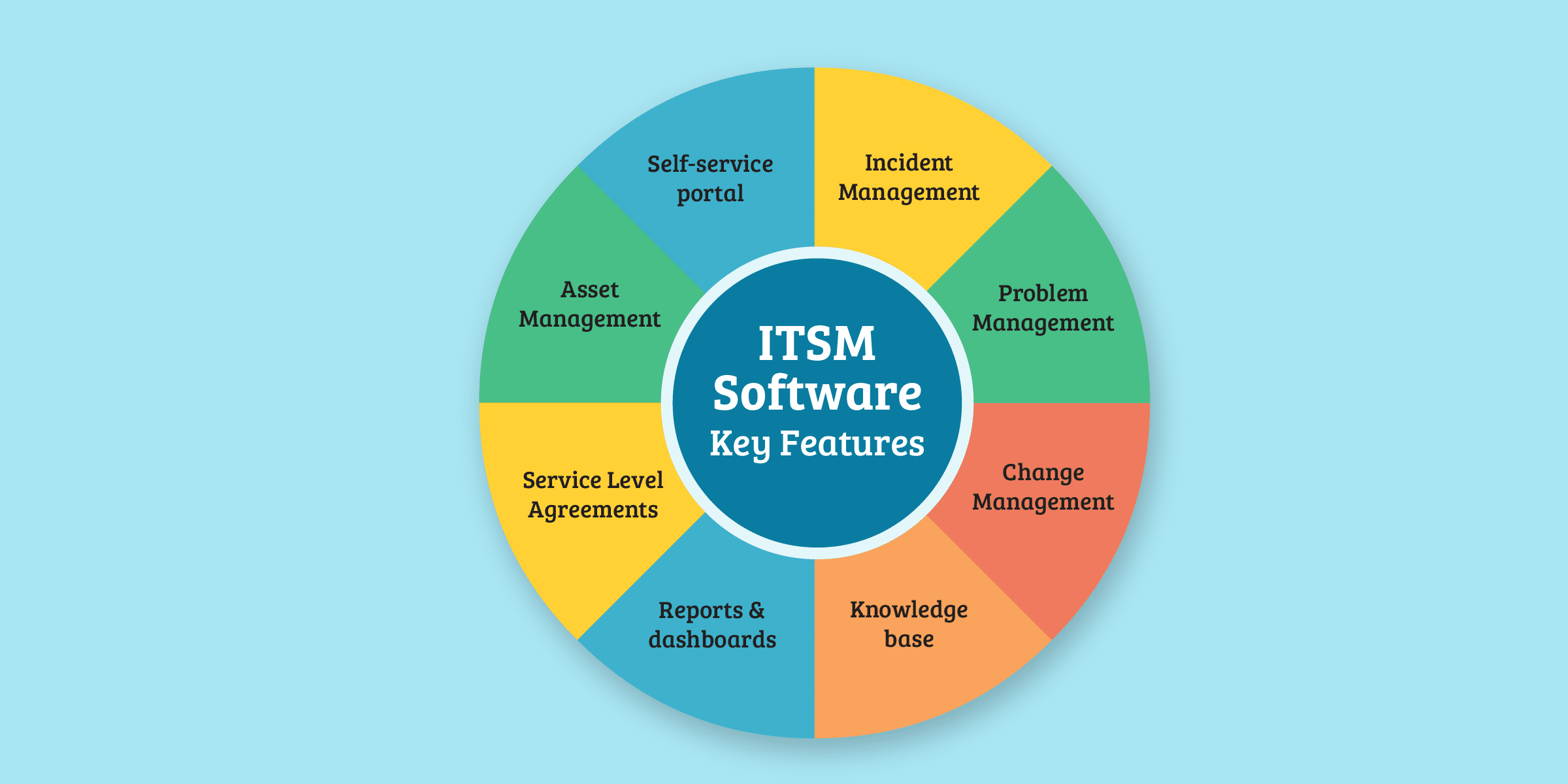ITSM Software Guide 2025
Everything you need to know about ITSM software
ITSM software is the ultimate hub for IT teams, streamlining everything from urgent fixes to routine requests. Read this guide to explore its benefits, compare various solutions, and find the perfect fit to enhance your organization’s IT management.
What is ITSM?
Before diving into the software, let’s talk about ITSM itself.
ITSM (IT Service Management) is a set of practices and principles that help IT teams deliver their services in a more strategic way.
Rather than being purely tech-focused, ITSM turns IT departments into a business partner that delivers value to your organization, including your end users or customers.
Many organizations use ITIL (IT Infrastructure Library) as their guidebook for ITSM. It’s like a collection of best practices that helps you get ITSM right.
Here’s a real-world ITSM example
Let’s say an employee’s laptop stops working. Without ITSM, the employee might message a few different IT people, none of whom have a full picture of the issue or know who’s handling it. The problem gets fixed eventually, but similar laptop problems keep happening to other employees.
With an ITSM approach, there’s a standardized process:
- The employee logs a ticket, describing the problem.
- The ticket is routed to the right IT support technician, who can access the employee’s device information and history.
- The technician diagnoses and resolves the issue, and lets the employee know when it’s fixed.
- If the IT team notices a pattern of similar laptop problems, they can investigate the root causes through their problem management process.
What are the most important ITSM processes?
The most important things you’ll need to manage are:
- Incidents: When something breaks and needs fixing fast.
- Problems: Getting to the bottom of recurring issues.
- Changes: Making changes to IT services and infrastructure without breaking things.
- Service Levels: Meeting your promises about response times and quality.
- Assets: Keeping track of your IT equipment and software, their value and costs.
- Configurations: Understanding technical relationships of your configuration items.

Are there any benefits to ITSM?
As an IT manager, you’re the unsung hero of your organization—after all, not all heroes wear capes. When it comes to IT Service Management (ITSM), the benefits go far beyond quick fixes—they redefine how IT supports and drives your business.
1. Stop the firefighting
Instead of always reacting to major incidents, you can become proactive and avoid common issues in the first place. It’s not just about fixing things fast—ITSM helps you run IT like a professional service. Improving the quality of your services means fewer panicked calls to IT and more productive workdays for everyone.
2. Fewer headaches, more customer satisfaction
Having repeatable ITSM processes means you have clear steps for handling every type of IT task. This leads to a better customer experience and fewer disruptions.
3. Add value to your business
ITSM helps you align IT with your organization’s business needs and objectives. Thanks to success metrics, everyone will see that IT is more than a support function – it’s the backbone of IT services that help your business innovate and grow.
4. Reduce risks and control costs
By implementing standardized processes and proactive management, ITSM helps organizations minimize IT-related risks, avoid the cost of system failures and manual fixes, and optimize resource allocation. You’ll spend less time and money on reactive solutions and more on strategic improvements.
5. Improve team collaboration
ITSM breaks down silos between IT and other teams, creating a unified approach to service delivery. With improved communication, shared knowledge bases, and aligned workflows, your entire organization can work more effectively.
Calculate the value of your ITSM tool
- Quantify the ROI of your IT project
- Improve time to value
- Manage scope, people, time and deadlines
What is ITSM software and how does it work?
Now let’s talk software. ITSM itself is great, but without the right tools, it can be a real challenge.
ITSM software usually includes:
- A workflow management system that centralizes and streamlines incident, problem, and change management.
- A Configuration Management Database (CMDB) that links configuration items to issues.
Think of ITSM software as the mission control center for your IT operations. It’s not just about tracking issues—it’s about creating a system that helps your team work smarter, not harder.
It centralizes information, automates repetitive tasks, and provides real-time insights. From routing support tickets automatically to tracking progress on dashboards, ITSM software turns complex technical tasks into a manageable process.
Key features of ITSM software
ITSM software can be broken down into different types of features:
Core Process Features
- Incident Management: Log, track, and resolve issues in one place.
- Problem Management: Get to the root of recurring issues.
- Change Management: Plan, track, and roll out changes properly.
- Asset Management: Keep tabs on IT valuables and their lifecycle.
- Configuration Management (CMDB): Create a comprehensive inventory of IT assets and their relationships.
User Enablement and Support
- Knowledge Base: A searchable collection of solutions and how-to guides.
- Self-Service Portal: Submit and track service requests, access knowledge articles, and interact via web, email, or chatbot.
Reporting and Analytics
- Reporting and Dashboards: See team performance and demonstrate IT value.
- SLAs: Define and track service delivery levels.
- Performance Metrics and KPIs: Continuously improve service delivery.
AI and Automation
- AI-powered ticket routing: Automatically assign tickets to the right team.
- Predictive incident management: Use AI to foresee and prevent potential issues.
- Intelligent chatbots: Provide instant support for common IT queries.
- Smart Knowledge Base: Continuously improve self-service solutions by learning from past interactions.

ITSM software in practice
One real-world example of using an ITSM platform is the way you handle WIFI connection failures. Without ITSM software, a user might call your IT service desk, wait on hold, explain their issue, and then the IT person has to solve the problem manually.
With ITSM software, the user can simply log a ticket through the self-service portal, the ticket is automatically routed to the right person, and the WIFI is restored within your defined SLA – all without anyone picking up the phone. It’s a win-win for the user and the IT team.
Enterprise Service Management: How to apply ITSM principles to other departments
Here’s something interesting: more companies are starting to use ITSM principles beyond just IT. HR, facilities, and legal teams are using similar tools to manage their services better. It’s called Enterprise Service Management (ESM), and it’s worth keeping in mind if you think other departments might want to join in later.

Why you (and your IT team) will love ITSM software
There are a million reasons why using an IT service management tool will improve your quality of work life. But here are a few of our favorite reasons why we love ITSM:
1. No more juggling tools
Solve problems, answer questions and share knowledge in one place. No more switching between different systems or losing track of requests in email threads.
2. Crystal-clear communication
Everyone can see what’s happening with their requests. No more “when can I expect an answer?” questions. End users can check the status themselves.
3. Faster problem-solving
Your team can fix issues more quickly because they have all the information they need at hand. Also, ITSM tools automate a lot of mundane or routine manual tasks.
4. Empower end users
Give your colleagues the tools to help themselves. Self-service portals, knowledge bases, and intuitive interfaces mean fewer frustrating wait times and more independence for everyone.
5. Stay ahead of issues
Instead of constantly putting out fires, you can spot patterns and fix underlying problems before they cause major headaches.
6. Break down silos
Improve collaboration within your team and between departments – with shared visibility and better communication that make cross-team problem-solving a breeze.
7. Prove your value
ITSM software gives you reports to show management and C-Suite how your IT efforts are creating real business impact.
These benefits add up to happier users, a stress-free IT team, and a stronger partnership between IT and the rest of the organization. When people can count on IT to reliably solve problems and fulfill requests, it frees up your team to focus on higher-value projects that move the business forward.

How to choose the right ITSM software
When you’re shopping around for ITSM software, there are several things you should consider:
- Budget: ITSM tools can range from a few dollars per user per month to enterprise-level pricing
- Deployment model: Cloud-based, SaaS or on-premises?
- Customization needs: How much do you want to tailor the software to your processes?
- Integration requirements: Does it need to connect with your other business systems?
- Reporting capabilities: What kind of insights and metrics do you need?
- Support: Do you value personal guidance both during and after implementation?
- Security and compliancy: Does the software meet your organization’s standards for data protection, regulatory compliance, and risk management?
What are the different types of ITSM software?
There are many ITSM software options out there with different approaches to ITSM. We’ve broken them into the following categories:
Readily available tools
Tools like Excel, Email or Teams can be used for ITSM. These tools are often free, generally easy to use and it’s likely you already use them for other purposes. The downside is that they’re not dedicated ITSM tools, and they aren’t standardized or based on ITSM best practices.
We’ve actually reviewed and analyzed both excel and email as ticketing systems so you can see when they may or may not be a suitable option for your organization- check them out here!
- Excel ticketing systems: Time to swap spreadsheets for an ITSM solution?
- Email ticketing systems: A handy guide
Enterprise-focused solutions
Think BMC Remedy or ServiceNow – ITSM tools built for big, highly complex organizations with deep pockets. They often have many features and are custom-made for your organization’s exact needs. But they also come with a number of drawbacks: the subscription costs are often high – and the complexity means they take a long time to build and deploy, which adds to the cost. They require extensive user training, and it takes a specialist to adjust and maintain the software, meaning you’ll need to splurge on a dedicated team of developers to make any changes.
Want to learn more? Read the comparison on ServiceNow and TOPdesk ITSM.
Product-led platforms
Plug-and-play tools like Jira Service Management or Freshservice are quick to set up without any guidance. They come with limited customization options, which often benefits teams that don’t have specific needs. The fresh, modern look and feel is countered by the fact that they lack best practices, guidance and expertise. Support and services are also minimal and often outsourced. As a result, if your IT team’s processes aren’t optimal, product-led platforms won’t improve this situation.
Want to learn more?
- Read the comparison on Freshservice and TOPdesk ITSM.
- Read the comparison on Jira Service Management and TOPdesk ITSM.
Build-your-own/open-source solutions
Some companies build fully custom ITSM solutions in-house. This gives you the flexibility to fully create the software to meet your organization’s needs. The downside is they require a lot of technical know-how from certain individuals, and they lack support and scalability. It can be difficult to keep the software aligned if your organization’s needs change, so these tools often become clunky and outdated quickly.
Adaptable solutions
Adaptable solutions like TOPdesk are ideal for mid-sized organizations. This standardized tool offers quick setup like product-led platforms, but includes built-in best practices and personalized support from sales and consultants who help customize the tool to your needs.
Teams can start small, add features as needed, and expand to other departments over time. Tweaking the tool requires no coding or technical expertise, allowing teams to adapt to changes quickly. However, it may not be suitable for large organizations with complex ITSM needs.
Calculate the value of your ITSM tool
- Quantify the ROI of your IT project
- Improve time to value
- Manage scope, people, time and deadlines
Popular ITSM software vendors and tools
Here are some of the leading ITSM software solutions in the market. Each offers unique features and benefits, catering to organizations of various sizes and industries.
TOPdesk
TOPdesk simplifies ITSM with an intuitive platform that offers management of all your ITSM processes in one place. Designed for ease of use, it enables IT teams to focus on delivering exceptional service without unnecessary complexity.
SysAid
SysAid delivers a robust ITSM solution with features like asset management, incident tracking, and self-service portals, designed to empower IT teams in small to mid-sized organizations.
SolarWinds Service Desk
SolarWinds Service Desk offers a comprehensive ITSM platform focused on simplifying service management and asset tracking, catering to organizations of all sizes with its user-friendly design.
ManageEngine
ManageEngine ServiceDesk Plus provides an all-in-one ITSM platform with advanced automation, CMDB, and ITIL support, ideal for mid-sized to large enterprises.
Xurrent (formerly 4me)
Xurrent, previously known as 4me, offers seamless service management with a strong focus on collaboration between internal IT teams and external service providers.
HaloITSM
HaloITSM is a modern ITSM platform designed for efficiency, providing an intuitive interface and features like ticketing, asset tracking, and SLA management to streamline IT operations.
ServiceNow
ServiceNow is a market leader in ITSM, offering a highly customizable and scalable platform designed for enterprise-level organizations.
Freshservice
Freshservice by Freshworks is a cloud-based ITSM tool designed for ease of use, with features that cater to IT teams and other business functions.
Zendesk
Primarily known as a customer service platform, Zendesk also offers ITSM capabilities for small to medium-sized organizations.
BMC Helix
BMC Helix provides AI-driven service management solutions tailored for large organizations seeking high performance and reliability.
Jira Service Management
Jira Service Management by Atlassian brings ITSM capabilities into the same ecosystem as its popular project management tools.
ITSM software in your technology ecosystem
ITSM software doesn’t work in isolation. It needs to integrate with the other tools and systems your organization uses. Modern ITSM platforms feature integration capabilities that connect with various business technologies.
Key integration features typically include:
- Direct APIs for custom connections
- Pre-built integrations with popular business tools
- Ability to connect with:
- Project management systems
- Communication platforms
- Customer relationship management (CRM) software
- Monitoring and alerting tools
- HR and facilities management systems
When a critical IT issue is detected, your ITSM software can:
- Create tickets in your project management system
- Send notifications to specific communication channels
- Update relevant databases and tracking systems
- Trigger alerts in monitoring platforms
When selecting an ITSM solution, carefully evaluate its integration capabilities. The right tool should enhance your existing technology ecosystem, not complicate it. Look for platforms that offer flexibility, easy configuration, and support for the specific tools your organization uses.
Why TOPdesk might be perfect for you
The right ITSM software can help your IT team to stop firefighting and get back to adding value, innovating and helping your organization grow.
If you’re looking for a solution that lets you start small, is flexible enough to customize and expand to other departments, and includes plenty of best practices and guidance so you don’t have to reinvent the wheel, TOPdesk is worth checking out. Here’s why:
Anyone can use it: The user-friendly interface makes the tool accessible for both IT staff and regular employees. You’ll receive on-site training and other training materials to make onboarding hassle-free.
All in one place: TOPdesk brings together all the core ITSM capabilities in a single, integrated platform. No more juggling multiple tools.
Plays nice with others: TOPdesk’s Marketplace and API lets you connect with other systems you’re already using, from Lansweeper to chatbots.
Keeps you flexible: You can set it up, personalize and tweak the tool around your ever-changing needs without needing a computer science degree.
Improves collaboration between teams: TOPdesk can be shared by IT, HR, Facilities, Finance and other service departments, making it easy to deliver consistently great services together.
Personal touch: Before, during and after implementation, you’ll get all the help you need. Our sales experts and consultants have plenty of hands-on experience, and our support team can answer any questions in your local language.
Shows your impact: Plenty of reporting features give you the data you need to demonstrate IT’s strategic value to the business.
Keeps things safe: In addition to storing data on servers located around the world, TOPdesk has all the security and compliance features you’d expect from an ITSM solution.
One last point on TOPdesk: Our customer support is consistently praised as some of the best in the ITSM software market- it was recognised as a Customer’s Choice by Gartner’s Peer Insights. You get a true ally, not just a transaction.
Ready to get started with TOPdesk?
- Quick to set up with templates and best practices
- Easy to tweak for continual service improvements
- Enjoy guidance from real people, every step of the way
FAQ
What's the difference between ITSM software and regular help desk software?
ITSM software is a much more comprehensive solution compared to a basic help desk or ticketing tool. While help desk software is focused on just handling individual support requests, ITSM platforms manage the full lifecycle of IT services – from solving incidents to analyzing problems to planning changes. ITSM brings structure, automation, and insights to your entire IT operations.
Do I need ITSM software if I'm a small team?
ITSM principles and practices can benefit organizations of any size, but the specific ITSM software you choose will depend on the complexity of your IT environment and service catalogue. Smaller teams may find lightweight ITSM tools to be a better fit initially. As you grow, you can always migrate to an enterprise-grade platform – or you can choose a tool like TOPdesk that grows with your needs.
Can ITSM software integrate with our other business systems?
Yes, a key benefit of ITSM platforms is their ability to connect with other critical applications you use, from CRM to project management to HR tools. This eliminates data silos and ensures a flow of information across your organization. The specific integration capabilities will vary by ITSM vendor, so ask about that when evaluating solutions.
How much does ITSM software typically cost?
ITSM software pricing can range quite a bit, from a few dollars per user per month for smaller tools up to enterprise-level pricing in the hundreds of dollars per user. Factors like deployment model (cloud vs on-premises), feature set, and scalability will all impact the cost. Be sure to account for not just the license fees, but also implementation, training, and ongoing maintenance expenses. These also include hidden internal costs like the effort to deploy and maintain the tool yourself.
Is ITSM just for IT, or can other teams use it too?
The core ITSM principles and processes can absolutely be applied beyond just the IT department. That’s where the concept of Enterprise Service Management (ESM) comes in – using ITSM software and methods to improve service delivery across the entire organization, whether that’s HR, facilities, legal, or any other business function. Many ITSM platforms are designed to be used company-wide.


